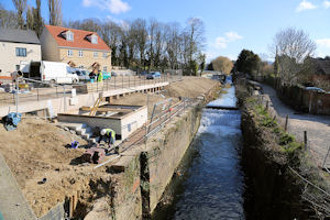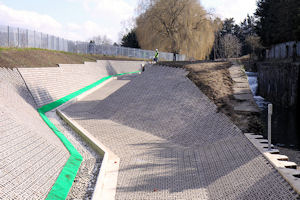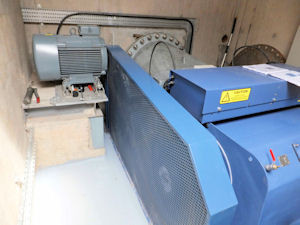THE Cotswold Canals Trust and the Stroud Valleys Canal Company, working together in a joint project, have completed their hydro electric scheme at Dudbridge.
The scheme will use the water overflowing from the disused waterway to generate power that will provide cash to help the restoration of the Cotswold Canals, and subsequently its maintenance.
 Diverted
Diverted
The water that flowed over concrete dams from the Stroudwater Canal that were installed in the 1950s, and now used as a flood relief scheme will be diverted through the hydro system to generate power that will be sold to the National Grid.
The Hydro scheme has been built in parallel with the main flood bypass system and, apart from the water being used by the fish and eel passes, can efficiently use the whole flow for 85% of the time in an average year. At very low flows, the turbine does not run and in very high flows, excess water flows over the large bypass weir which takes the water around the locks and the turbine.
 In a typical year, the hydro scheme is expected to generate an income of £20,000 through the generation of over 100 Megawatt hours of electricity.
In a typical year, the hydro scheme is expected to generate an income of £20,000 through the generation of over 100 Megawatt hours of electricity.
Back into canal
The turbine house is located largely underground by the lower lock and is connected to the intake by a 900mm diameter pipeline. This feeds into the turbine and the water drops through the floor of the turbine house through a draught tube where it joins the outlet of the main flood channel prior to rejoining the canal under the road bridge below the lower lock.
 As the project was so totally bound up with the canal restoration project, little could be done until work was due to start on the civil engineering works being managed by Stroud District Council in 2011. It was then a matter of finalising the design and seeking the funding needed to build the hydro scheme at an estimated cost of just over £300,000.
As the project was so totally bound up with the canal restoration project, little could be done until work was due to start on the civil engineering works being managed by Stroud District Council in 2011. It was then a matter of finalising the design and seeking the funding needed to build the hydro scheme at an estimated cost of just over £300,000.
Control by mobile smart phone
The control system stores information about the operation of the turbine and if something goes wrong, will issue an alert over the Internet. The entire system can be monitored and managed remotely using a PC or even a mobile smart phone.
The installation is expected to last many decades with little more than the occasional replacement of bearings and drive belt expected to be necessary. A small team of volunteers has been formed to perform regular maintenance tasks with the main one being to clear any debris away from the intake or fish pass.
Photographs by Mike Gallagher.
